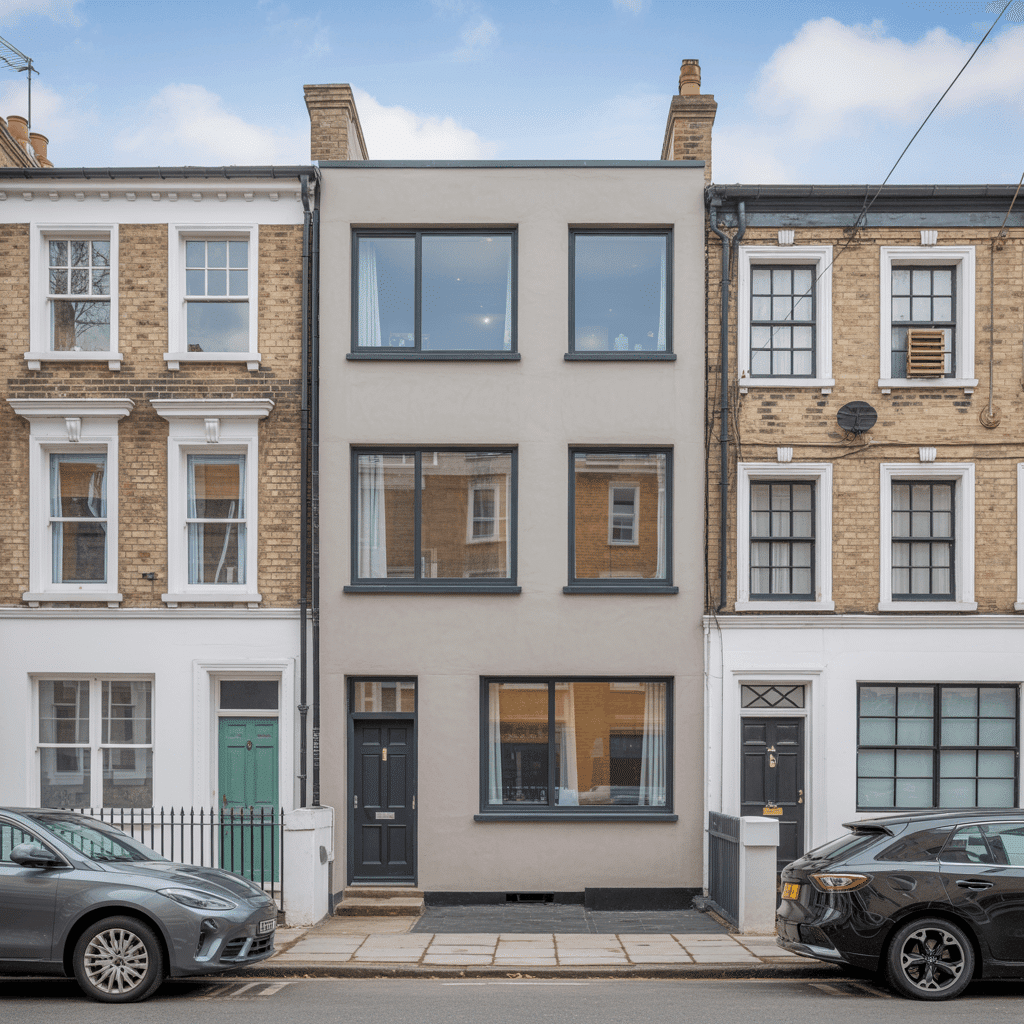The Silent Saboteur in Your Home: Poor Glazing
Up to 30% of a building’s heat is lost through its windows. In premium properties, the figure can climb even higher. Why? Because style has too often triumphed over substance. Because “double glazing” became shorthand for performance. And because, until recently, glazing was rarely held to the same standard as the rest of the building envelope.
In the Southeast — where architectural heritage meets unforgiving climate — the consequences are especially acute. Draughts slip through unsealed frames. Condensation forms on underperforming panes. Street noise infiltrates otherwise peaceful interiors. And energy costs escalate quietly, year after year.
Glazing rarely announces its failure.
It reveals itself subtly — through a failed EPC, a delayed planning approval, or a living space no one uses.
Passive windows are designed to reverse this equation.
They lock in thermal comfort, mute urban noise, and integrate modern performance into classical architecture — all without compromising on visual integrity. But delivering that level of performance is not simply a matter of product selection.
It is a matter of expertise.
And true expertise is harder to find than most clients realise.
This article isn’t a product pitch.
It’s a technical and strategic brief — focused on the professionals who understand Passive as a standard to be engineered, not a buzzword to be marketed. Because even the highest-spec glass will underperform if it’s mismeasured, misapplied, or misunderstood.
If your project demands more than the industry’s usual compromise, start here.
What Does ‘Passive’ Actually Mean — and Why You Need It
Most people think “Passive” means “triple-glazed.” It doesn’t.
Passive is a performance threshold — a measurable standard born from the rigorous Passivhaus Institute in Germany and now shaping the future of British building regulations. It’s the difference between windows that look efficient on paper and windows that actually perform for decades.
A true Passive window isn’t just thicker glass. It’s an integrated system where:
- The U‑value of the glass, frame, and spacer combined drops below 0.8 W/m²K.
- Airtight seals eliminate draughts, even in high‑wind coastal sites.
- Thermal bridges are broken at every junction, so heat stays in, cold stays out.
- Acoustic layers dampen traffic noise, so a Knightsbridge drawing room is as quiet as a country retreat.
This level of engineering is invisible. You don’t see the argon fill or the warm‑edge spacer bars. You just experience rooms that are consistently comfortable, quieter and cheaper to heat. That’s why architects and serious homeowners across Southeast England now specify Passive windows as standard. It’s not an indulgence — it’s an investment in future‑proofing.
And here’s the point, the brochures don’t tell you: a Passive window will only hit those numbers if the installer understands the whole building envelope. A misaligned frame, a compromised seal, a wrong fixings sequence — and the window you paid for stops being Passive the moment it goes in the wall.
In other words, you’re not just choosing a product; you’re choosing an outcome.
The right installer delivers that outcome. The wrong one leaves you with an expensive compromise.
That’s why, in Southeast England, with its conservation areas, microclimates and vigilant building control, picking the right Passive window installer isn’t a side detail. It’s the most important decision you’ll make on your project after choosing your architect.
The Southeast Challenge: Planning, Prestige, Performance

The Southeast of England is not an easy place to build or renovate. It’s a region where homes wear history like a badge of honour — and planners guard every window line with a sharp pen. You don’t just need performance here; you need elegance, discretion, and approval.
In Kensington and Notting Hill, conservation officers won’t entertain anything that breaks with the street’s historic character. In Brighton, seaside corrosion eats into subpar frames. In Guildford or Tunbridge Wells, the balance between modern standards and heritage expectations grows tighter with every project.
And yet — performance requirements keep climbing.
Part L demands airtightness. Part Q insists on security. EPC ratings influence mortgages. Even private clients now ask about U-values before they ask about handles.
This is the Southeast Glazing Dilemma:
- You must meet modern standards (thermal, acoustic, security, sustainability)
- You must preserve period aesthetics (sash profiles, putty lines, timber tones)
- And you must pass local planning approval — first time
Most installers specialise in one of those areas. Very few master all three.
The best Passive window installers in Southeast England are the ones who understand this region not just geographically — but architecturally, politically, and aesthetically. They know the difference between a Georgian conservation officer and a modernist architect. They know how to embed triple glazing into a listed building — and how to defend it on a planning call.
They don’t simply sell windows. They solve problems most people don’t know exist until it’s too late.
This is where their true value lies — not in the product alone, but in the ability to deliver it flawlessly within a complex regional context.
Coming up next: how to spot them before you sign the wrong contract.
7 Signals of a Genuine Passive Glazing Expert
Let’s be clear: anyone can claim “energy-efficient” or “Passivhaus-compliant.”
But when the install begins, most firms are still using the same tools, habits, and shortcuts they used on uPVC refits in the 1990s.
The difference between a Passive window installed properly and one installed poorly isn’t subtle — it’s systemic. And it will show up in your EPC, your comfort levels, your planning outcomes, and your bills.
So how do you separate the true Passive professionals from the sales-driven imitators?
Here are seven signals that you’re dealing with someone who doesn’t just understand glazing — but engineers outcomes.
1. They Provide U-Values by Component, Not Just Overall
Most quotes list a single U-value. Real experts break it down:
- Glazing centre
- Frame U-value
- Spacer bar conductivity
- Edge loss factors
This is what tells you whether you’re buying marketing or measurable performance.
2. They Offer Thermographic Imaging Before and After
Passive installers understand heat movement.
They’ll offer pre-install infrared scans of your current setup — and post-install scans to prove the upgrade.
This isn’t salesmanship. It’s engineering validation.
3. They Can Handle Alu-Clad, Composite & Hybrid Frames
Most installers are fluent in timber and PVC. Passive-grade installers handle:
- Aluminium-clad timber (for zero maintenance + insulation)
- Thermally broken composites
- Vacuum-glazed hybrid systems
These aren’t cosmetic upgrades — they’re how modern Passive designs deliver ultra-low U-values with design integrity.
4. They Know Part L, Part Q, Part K by Heart
Planning officers don’t care what your brochure says. They care about:
- Thermal bridging under Part L
- Locking systems under Part Q
- Fall protection under Part K
Your installer should build these into the spec and submit-ready documentation — not wait until Building Control redlines your drawings.
5. They Show Proven Heritage Integrations
Anyone can sell triple glazing. Very few can do it in a conservation area.
Your installer should show:
- Examples of flush sash Passive windows
- Slimline profiles approved in heritage districts
- Prior planning approvals on sensitive sites
- Georgian bar & horn detailing, without thermal compromise
If they’ve never replaced windows in a listed property, keep moving.
6. They Guarantee Acoustic Performance
In London and along rail corridors, sound insulation is as critical as heat insulation.
Ask to see:
- Rw ratings (Weighted Sound Reduction Index)
- Installation detailing for perimeter sealing
- Compatibility with acoustic laminated glass
Real Passive installers don’t guess — they measure.
7. They Integrate with Your Architect or Builder
A true Passive specialist isn’t just a contractor — they’re a collaborator.
They’ll liaise with your architect. Coordinate with your M&E consultant.
Ensure airtightness detailing aligns with other fabric upgrades.
They don’t just fit windows — they make your whole envelope work.
In short:
Look past the logos, the claims, and the polished websites.
Ask better questions. Demand evidence.
You’re not buying a window — you’re buying results.
Next, we’ll look at the invisible beauty behind Passive window design — and how true installers make high performance disappear into high aesthetics.
Design Matters Too: The Art of Invisible Performance
In high-end architecture, compromise is the enemy.
It only takes one poorly detailed window — too bulky, too shiny, too obviously “engineered” — to ruin the entire elevation.
That’s why the best Passive window installers understand something most others don’t:
Performance is not enough. The frame must disappear into the façade.
When Passive House first entered the UK, it was greeted with suspicion.
Triple glazing was clunky. Frames were fat. Sightlines were sacrificed on the altar of efficiency. The result? Projects that met the spec but betrayed the brief.
Performance won. Beauty lost.
But today, the game has changed.
Modern Passive systems — when installed by a team with both aesthetic intelligence and technical rigour — don’t just meet building standards. They elevate architecture.
How the Best Make Performance Invisible
✔️ Slimline triple glazing: Now available with U-values <0.8 W/m²K
✔️ Warm-edge spacers: No black lines, no condensation risk
✔️ Thermally broken frames: Rendered in timber, alu-clad, or hybrid finishes
✔️ Putty-line profiles: Matched to Georgian or Victorian heritage styles
✔️ Hidden seals and gaskets: Airtight without visible bulk
✔️ Rebated sashes and glazing bars: Historic detailing, modern compliance
It’s not magic. It’s meticulous engineering — done by people who know that design isn’t window dressing. It’s the language of the building.
Aesthetic Integration Isn’t a Service. It’s a Standard.
True Passive installers treat aesthetics as a constraint from day one, not an afterthought.
They liaise with conservation officers before spec sheets.
They prepare mock-ups for client review.
They offer CAD overlays, heritage detailing options, and finishes that blend seamlessly with listed façades.
They don’t ask you to choose between compliance and beauty.
They deliver both — by design.
Because in Southeast England, a window isn’t just a product.
It’s a statement. And the wrong one will haunt your project for decades.
Compliance Without Friction: From Planning to Approval

It’s one of the most overlooked facts in glazing:
A window can meet every technical spec — and still fail your project.
Why?
Because compliance is not just about performance — it’s about process, paperwork, and permission.
In Southeast England, your Passive window installer isn’t just fitting glass.
They’re navigating a regulatory minefield that spans Part L (thermal efficiency), Part Q (security), and Part K (safety from falls) — all under the watchful eyes of planning officers, building control, and conservation bodies.
The difference between months of delays and a smooth installation?
Your installer’s ability to deliver frictionless compliance from day one.
Part L — Thermal Performance
The cornerstone of Passive design. Your installer should deliver:
- Verified U-value breakdowns (not just marketing estimates)
- Psi-values for frame junctions
- Thermal bridging documentation
- Optional thermal modelling or SAP contribution analysis
This isn’t just about ticking boxes — it’s about proving, in advance, that your windows won’t compromise the entire envelope’s efficiency.
Part Q — Security
In most zones, particularly London, your windows must meet Secured by Design standards.
Elite installers:
- Specify multi-point locking systems compatible with Passive frames
- Ensure laminated or toughened glass is used where required
- Offer Part Q certificates for submission to Building Control
If your project is in a mixed-use or multi-storey development, this is non-negotiable.
Part K — Fall Protection
Especially critical for upper floors, French doors, and Juliet balconies.
Expect your installer to:
- Identify critical glazing zones
- Recommend compliant guarding or restrictors
- Ensure opening styles don’t breach protection rules
One misstep here and your window spec will be rejected — no matter how beautiful it looks.
Planning & Conservation Approval
And then there’s the art of navigating the planners.
For properties in conservation areas or within the curtilage of listed buildings, approvals hinge on:
- Section drawings that prove like-for-like sightlines
- Material samples and finish documentation
- Prior examples of approved Passive installations in similar contexts
If your installer can’t provide a proven track record with planners, your project is already on shaky ground.
This Is What Great Installers Do Differently
✅ Prepare ready-to-submit compliance packs
✅ Provide dwg/CAD files for architectural integration
✅ Coordinate directly with planning consultants or case officers
✅ Pre-empt objections — because they’ve dealt with them before
✅ Deliver planning-safe aesthetics with certified performance
Because when friction disappears, performance isn’t just promised — it’s approved, installed, and working.
Why the Cheapest Quote Is Often the Most Expensive Mistake
In high-end building and renovation, cutting corners rarely saves money.
But when it comes to glazing — especially Passive-grade glazing — the illusion of savings can be catastrophic.
You’ll see the ads.
“Triple glazing from £XXX per unit.”
You’ll receive the quotes.
“Includes Part L compliant glass.”
And it’s tempting. Passive windows can look expensive on paper.
But here’s the reality: the cheapest option often costs you the most.
Hidden Costs of a “Cheap” Passive Window Quote
✅ Non-compliant specs that fail Building Control → costly replacements
✅ Frame-only performance figures that don’t include installation loss
✅ Delays in planning approval due to missing technical documents
✅ Failed site inspections due to misaligned safety features (Part K, Part Q)
✅ Callbacks and rework from poor airtightness or condensation issues
✅ Angry clients or architects when aesthetics are compromised
✅ Reduced resale value due to failed EPCs or inferior acoustic rating
Suddenly, the “cheaper” quote isn’t cheap at all.
The Real Cost of Poor Performance
Let’s do the maths.
A home leaking 25% more heat due to substandard glazing could easily cost £750–£1,200 per year in excess energy bills.
Over a 10-year period, that’s £10,000 lost — not counting the environmental impact or loss of comfort.
Add to that planning delays, redesign fees, or — worst of all — having to rip out and replace what was just installed.
That £1,800 you thought you saved on installation?
Gone — and then some.
What You’re Really Paying For
With a genuine Passive window specialist, you’re not paying for glass.
You’re paying for:
- Thermal integrity is engineered into every joint
- Seamless aesthetic integration into your architectural vision
- Compliance handled without red tape
- Performance that doesn’t degrade over time
- Peace of mind that you won’t be revisiting this decision in five years
These things are invisible on a spreadsheet.
But they’re felt every day you live in the home — and every time someone else wants to buy it.
The real value of Passive isn’t just in what it gives you.
It’s in what it protects you from.
Where to Start: A Smart Homeowner’s Next Step
You now know what most people don’t.
You’ve seen what Passive really means — beyond the marketing gloss.
You’ve understood the stakes — not just in comfort or performance, but in planning, resale, and a long-term financial sense.
You know how to separate a true Passive specialist from a glass seller.
And you understand that in Southeast England, you don’t just need a window — you need a partner who delivers certainty.
So where do you begin?
Start with Proof, Not Promises
No pushy sales calls. No vague quotes.
Instead, request a clear, performance-led consultation that answers:
- What U-value do you need — not just at the glass, but at the wall interface?
- Which products work in your planning context — and which don’t?
- How can your aesthetic brief be achieved — without compromising compliance?
- What do your next steps look like — from pre-spec to install?
What to Ask For
✅ A thermal assessment of your current setup
✅ Project images & U-value specs from similar homes in your area
✅ Sample documentation for Part L, Q and K
✅ Window profiles, finishes and CAD drawings to match your home
✅ A project plan that coordinates with your builder or architect
The best Passive installers offer this not as extras, but as standard practice.
Your Window Decision Is Permanent. Choose Like It Is.
Windows aren’t furniture.
You don’t change them when styles shift.
You live with the consequences for decades.
So don’t gamble on the cheapest quote.
Don’t hope the planning officer will wave it through.
And don’t believe performance is just about glass.
Start with a Passive partner who’s already delivered everything you’re looking for — and everything you haven’t thought to ask yet.
Ready to take the first step?
Let’s talk.
Not about windows — but about the performance, comfort, value and beauty they should deliver.
Because when it’s done right, you don’t notice the window at all.
You just notice how good your home feels.







